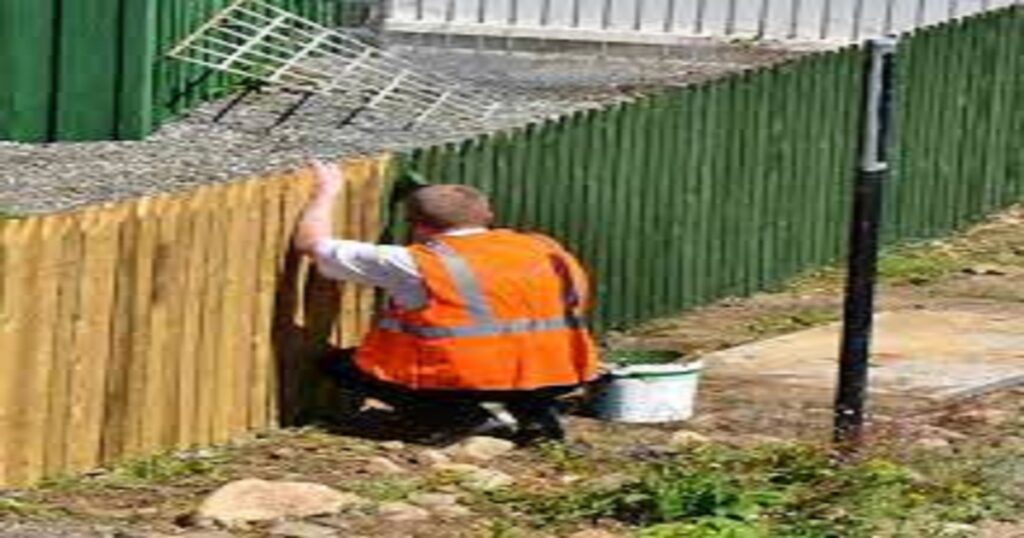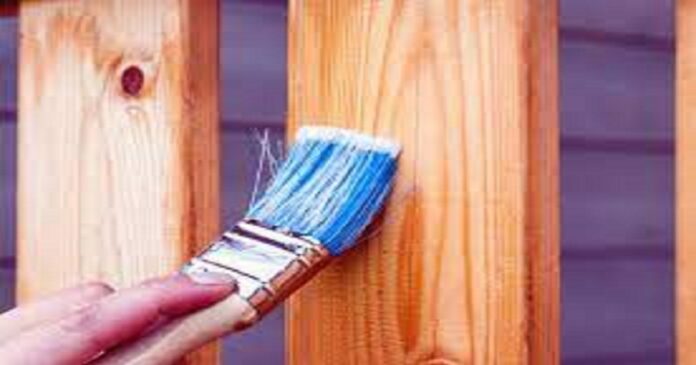Fence Painting:
Whether you are planning to renew your garden’s fence with new paint or just refreshing the weather-worn paint of the fence, having knowledge about painting your fence is a great way to give your outdoor space a new look.
Painting a fence is not just as simple as you think. Before beginning, you need to consider many things and some painting factors to make the painting process smooth, like weather, color, type of paint, surrounding, etc.
So, this article will cover in detail how you can do fence painting efficiently and effectively in this season. This article will cover the types of paint you choose, prepare your fence prior, fence painting options, and essential tips.
So, keep reading this article.

Before You Start:
Now you have decided to start your fence painting; you should consider the following things before starting.
- Plan for any help earlier to make the process faster and possible.
- Research your paint or stain prior, choose a long-lasting paint in the finish and see how the paint or stain shade will appear the way to Paint a Fence.
- Make a budget for your paint and list the tools and materials required.
- Do essential repairs to the fence and prepare the painting area beforehand.
- Check the weather forecast to calculate a suitable period to finish the project. It is good to work on your fence painting in the temperature ranges between forty and ninety degrees Fahrenheit and humidity is low to mild. The day when the precipitation rate is higher than the time essential for drying the paint, don’t paint.
- Plan to finish the job within a designated time, including the time required to dry the fence.
- In addition to keeping the seal on your wooden fence, keep moisture away from the surface, keep the wood slightly above the grass level, and have grass and plants trimmed and trees out of direct contact.
- If you are dealing with toxic compounds or sanding the fence, you must use hand gloves and a face mask.
Types of paint to use for fence painting:
Not a single consent holds true on which type of paint is best for fences. The selection for the paint depends mainly on the fence structure like wooden, metal, or plastic, its location in the garden, and the weather conditions of the area.
You can choose to select one from the following different type of paints based on the structure of your fence, which are;
Oil-based Paint:
Oil-based paints, also called alkyd, is the best choice out of the three types of fence paints available. It maintains going the longest, so you will no longer want to repaint frequently, and it is also the maximum dust resistant, making it less complicated to clean from the surface. It can be used on metal fences to prevent them from rusting, stains, and discoloration.
These kinds of paints can take from six hours to a day to dry, which means, wait for the right weather conditions and patience to appear before the second coat.
Oil-based paints come in different variants like satin, semi-gloss, and gloss finishes. These variants are composed to survive outdoor weather issues.
Water-based Paint:
Water-based paints are also called plastic or acrylic paints. They are created with water, and people use them for a couple of reasons, ranging from outdoor fences to indoor partitions. One component humans like approximately acrylic paints is that they extend and settlement with changes in temperatures. It makes them exceptional for the wall considering they withstand breaking.
Primer Paint:
It is the foundation coat you apply to the fence before doing the paint. A couple of paints incorporate a primer in them, and in some options, there is the primer that you can buy separately.
Many paint manufacturers does not include a primer with them. If yes, you should purchase it separately and apply a primer first on the fence.
Sprayer vs. Paintbrush:
A paint sprayer is the best approach assuming that you are searching for a method for taking care of business quickly while keeping up with even inclusion. A paint sprayer is versatile and can cover walls, things being what they are, including metal and steel. Paint sprayers requires an intensive cleaning after use to guarantee that paint doesn’t dry in the lines or obstruct the shower firearm. They additionally utilize more paint, and because they make a fine fog, you’ll have to wear defensive stuff.
One benefit of the paintbrush or paint roller is their easy cleanliness. You can stop in mid-project, and either clean your brushes or store them in water/airproof packs until you can begin with them for next time. Pick a paintbrush or a restricted roller that is about similar width to the fence’s pickets. An augmentation shaft for the roller lessens the need to twist around to paint the minor segments of the fence. Assuming you’re utilizing oil-based paint, ensure you have mineral spirits or turpentine close by for cleanup.
Read more: What is Landscaping Gravel Type? Interesting Information You Need To Know
How to get Prepare to paint your fence:
Now that you have decided about painting your lawn fence, you also choose the type of paint according to the fence’s structure. Before starting to paint, the following steps are essential to get yourself prepared for the fence painting process so that things get done right.
- First, ensure that no vegetation or plants can hinder the fence. Otherwise, it may stick if the wind blows it around the garden. You should mow your lawn to clear the fence surroundings.
- Suppose you found trees or large plants around your fences. You might struggle to get around them. So, properly trim all the tree branches and shrubs around the fence.
- Cutting down the plants around the fence seems not a good idea, so try protecting any plants next to your fence by covering them with protective sheets of plywood in between plants and the fence. Be sure not to crush plants in the protection process.
- You can also protect the area under the fence by layering the protective plastic sheet underneath it. The sheet will collect any material that falls from the fence.
- It is always advisable to remove cracks and damages in the fence, fix old nuts, bolts, and screws, and get the fence in good shape before painting.
- In repairing, it is suggested to pressure wash it to remove any dirt of old paint. Wash it with high pressure and give it a blast. Please don’t leave it too long, though. Otherwise, the fence will soak and get moldy.
- You can add a Primer the moment once you have your fence prepared to paint. Primer will assist with preventing the fence from creating mold on it.
- Get the right paint and color for your fence. You can use dark or light colors depending upon the fence’s surroundings.
Important Tips to consider during fence painting process:
On a good note, make a routine to paint your fencing every two years at least to prevent it from structural repair or replacement. You can consider the following tips in the fence painting process to make this activity less costly and more beneficial.
Paint your fence in warmer months:
It is suggested that you check the weather forecast 24 hours before starting the task of painting the fence of your lawn. Check if the weather’s warm, it will allow the paint to dry more quickly and set better on the fence. In cold weather, the paint won’t dry quickly, and all your efforts get wasted in case of rain. So, dry conditions above 5C are feasible for painting.
Brush or sprayer:
It is advisable to choose the right tool for the paint. So, selecting the brush or the sprayer depends on the type of fence and its surface area.
A paintbrush is a fundamental tool more often used to paint when you desire to paint the fence on your own. A brush size of at least 100mm/4″ will cover surfaces quickly, while a smaller brush size of25-50mm/1-2″ helps easily fill gaps or awkward corners or shapes with paint. Doing paint with a paintbrush is a time-taking activity, and one should need to keep other factors in mind to complete it well.
If someone needs quicker results, using a power sprayer tool is better. Using pump sprayer in fence paints is a great way to paint large areas of fence in a fraction of the time. So, the selection of the paint type needs to be appropriately considered.
It is suggested not to use sprayers on windy days to avoid painful carnage.
About protecting your plants:
It is equally important to protect all the plants and vegetation prior to the fence painting. It can be done by covering them using plastic sheets.
Trim back any vegetation to give yourself ample space to work, and put resources into some plant ties and sticks on the off chance that any plants are as yet laying and can’t be covered or scaled back.
Clean your fence before painting:
Old nails or screws and hanging bins or designs will impede you while painting your fence, so you’ll need to clean them up before you begin.
Whenever that is done, sand down any harsh regions or splinters standing out on the boards; smoother boards make for better completion.
Apply primer layer:
Applying a primer won’t be a one-coat work.
Apply a primer layer to each of the panels and let it dry totally. Not in the least does this give a better completion. It will expand the time of protection managed by your paint.
Applying your chosen color:
You can start to paint the fence panels with your chosen variety of color shades by utilizing the device of your decision.
To get better results, use flat strokes for even sheets of wood and vertical strokes for vertical sheets. Also, heed the wood’s grain for a fine finish.
Apply paint well:
Don’t be vile about the quantity of paint you practice on your fence.
Apply an ample quantity of paint to make sure that it completely penetrates the wood for first-rate protection, so don’t be scared to slap it on.
Stay safe in the painting process:
Painting a fence could be quite an enjoyable task (even a piece dreary), yet it is full of risk.
So, consider the following to keep you safe while painting your fence.
- Keep away from eye sprinkles by wearing goggles.
- Wear proper or appropriate gloves for sanding or water-based paints or dissolvable-based items.
- While setting up the fence, wearing a residue veil is preferred to stay away from the inward breath of undesirable particles.
- Be careful; wear shoes if utilizing a stepping stool.
- If you get paint on your skin, wash it with warm water.
- If you get paint in your eyewash, quickly wash it with hot water.
Conclusion:
This detailed article covers all the necessary information that a homeowner should know before he starts the task of painting his garden fences. By getting sound knowledge about the type of paint and do’s and don’ts of fence painting, they can cost-effectively do it themselves.
If you feel the need that it is an appropriate time to paint your fence, by adhering to the following steps and guidelines, you can enjoy the entire painting process and the results. Also, you will avoid causing any unnecessary damage.










